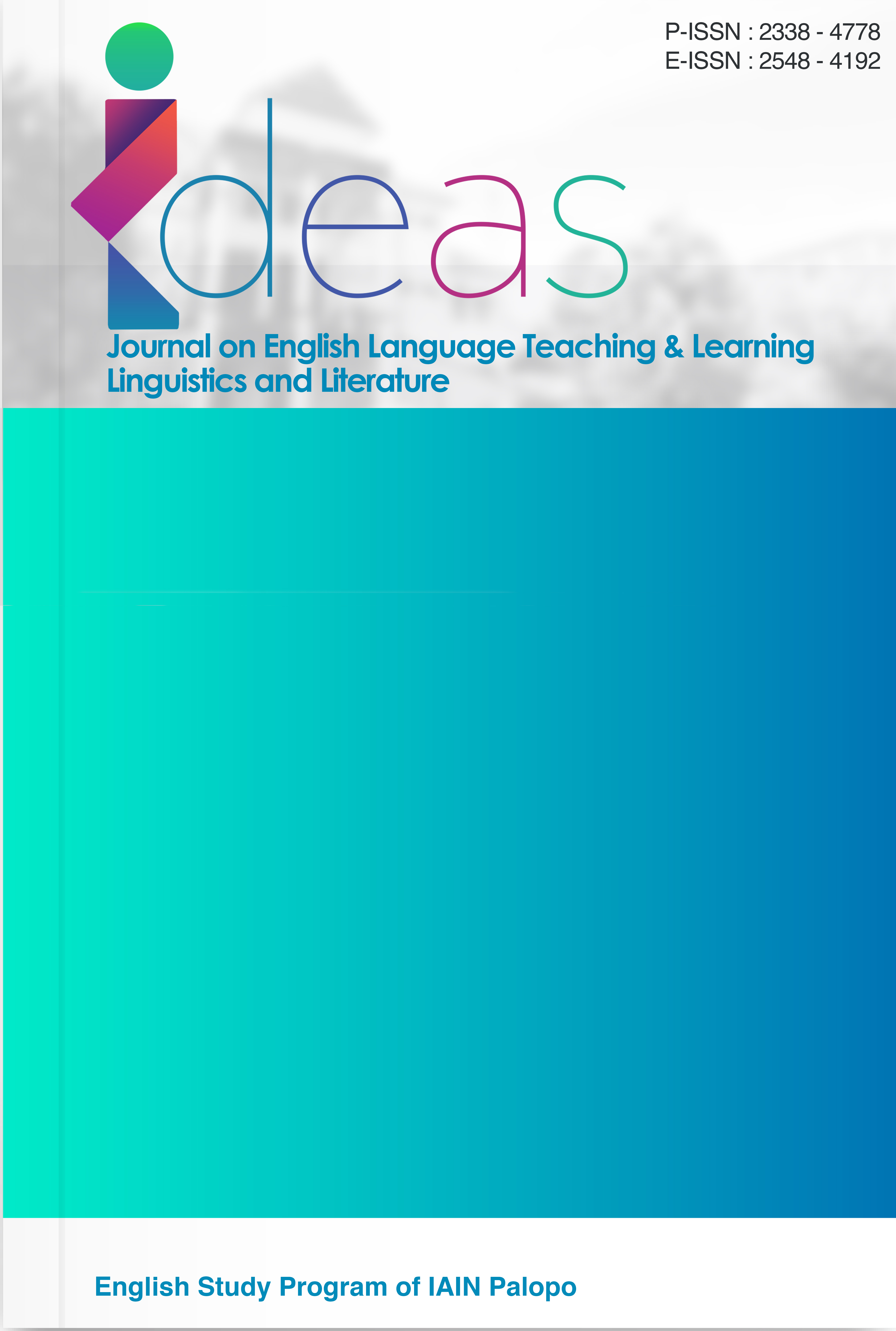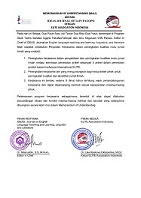Improving English Listening Skills for Vocational Students Through Interactive ICT Tools
DOI:
https://doi.org/10.24256/ideas.v13i2.8133Keywords:
Listening skills, vocational education, ICTAbstract
Vocational students often face difficulties in developing English listening skills, particularly with authentic speech that includes varied accents, fast delivery, and technical terms. This Classroom Action Research conducted at SMK N 2 Depok explored the use of interactive ICT tools—YouTube and ESLVideo.com—to enhance listening comprehension among 36 eleventh-grade Computer and Network Engineering students. The intervention applied a Genre-Based Approach in two cycles, using authentic YouTube videos for exposure to real-world discourse and ESLVideo.com quizzes for interactive practice with immediate feedback. Data from tests, observations, and interviews showed substantial progress: students’ mean listening scores increased from 71.25 to 90.83, accompanied by higher engagement and confidence. Qualitative findings revealed that visual and verbal integration reduced comprehension difficulty and motivated students to participate more actively. Despite challenges such as technical issues and classroom management, reflective adjustments helped maintain consistent improvement. The study concludes that integrating interactive ICT tools can effectively enhance vocational students’ listening competence and foster independent learning aligned with professional communication needs.
References
Adi, M., Nasrullah, N., & Rosalina, E. (2022). Investigating EFL students’ listening comprehension: Problems and causes. International Journal of Education, Language and Literature, 2(1), 12-25. https://doi.org/10.26740/elitejournal.v2n1.p12-25
Al-Jumaily, I. H., & Alazzawi, I. T. (2025). The influence of multimodal visual methodologies on EFL University students’ audio-visual comprehension, verbal and nonverbal communication. Journal of Language and Education, 11(2), 35-56. https://doi.org/10.17323/jle.2025.22731
Aziz, A. F., & Anjaniputra, A. G. (2025). The Alignment of ESP in Teaching Activities and Materials at Vocational High School. Tamaddun, 24(1), 60-72. https://doi.org/10.33096/tamaddun.v24i1.918
Bachman, L. (1990). Fundamental considerations in language testing. Oxford University Press.
Brown, H. D., & Lee, H. (2015). Teaching by Principles: An Interactive Approach to Language Pedagogy. Pearson.
Burns, A. (2010). Doing Action Research in English Language Teaching. Routledge.
Deci, E. L., & Ryan, R. M. (2000). The “what” and “why” of goal pursuits: Human needs and the self-determination of behavior. Psychological Inquiry, 11(4), 227–268. https://doi.org/10.1207/S15327965PLI1104_01
Denzin, N. K. (2017). The Research Act: A Theoretical Introduction to Sociological Methods. Routledge.
Dudley-Evans, T., & St. John, M. J. (1998). Developments in English for Specific Purposes: A Multi-Disciplinary Approach. Cambridge University Press.
Efendi, A. Y., & Astutik, Y. (2024). Podcasts Boost Listening Skills in Vocational High School Students: Podcasting Improves Listening Skills for Vocational High School Students. Indonesian Journal of Education Methods Development, 19(3). https://doi.org/10.21070/ijemd.v19i3.845
Febriani, H., Asvio, N., Rahmadoni, J., & Vivekanantharasa, R. (2022). Improving EFL learners listening skills by using audio visual aids. Linguists: Journal Of Linguistics and Language Teaching, 8(2), 216. https://doi.org/10.29300/ling.v8i2.7662
Feng, L., & Sumettikoon, P. (2024). An empirical analysis of EFL teachers’ digital literacy in Chinese higher education institutions. International Journal of Educational Technology in Higher Education, 21(1). https://doi.org/10.1186/s41239-024-00474-1
Field, J. (2008). Listening in the Language Classroom. Cambridge University Press.
Gardner, R. C., & Lambert, W. E. (1972). Attitudes and Motivation in Second Language Learning. Newbury House Publishers.
Goh, C. C. M., & Vandergrift, L. (2021). Teaching and learning second language listening: Metacognition in action. Routledge.
Hadist, M. K., Hidjanah, H., Dtakiyatuddaaimah, D., & Dewanti, L. (2022). An analysis of EFL students’ difficulties in listening comprehension at STKIP Muhammadiyah Bogor. Jurnal Education FKIP UNMA, 8(1), 174-179. https://doi.org/10.31949/educatio.v8i1.1847
Husnawati, N., Puspitasari, M., & Yundayani, A. (2024). Enhancing intrinsic motivation and listening skills through integrating authentic learning materials. English Review: Journal of English Education, 12(2), 559-566. https://doi.org/10.25134/erjee.v12i2.9761
Kemmis, S., & McTaggart, R. (1988). The action research planner. Deakin University Press.
Kemmis, S., McTaggart, R., & Nixon, R. (2014). The action research planner: Doing critical participatory action research. Springer.
Khairat, N. (2024). The use of YouTube to enhance learners’ English listening skills. Surakarta English and Literature Journal, 7(2), 134 147. https://doi.org/10.52429/selju.v7i2.265
Krashen, S. D. (1982). Principles and practice in second language acquisition. Pergamon Press.
Lave, J., & Wenger, E. (1991). Situated learning: Legitimate peripheral participation. Cambridge University Press.
Lertchalermtipakoon, P., Wongsubun, U., & Kawinkoonlasate, P. (2021). Need analysis: English language use by students in the tourism and hospitality and industry. English Language Teaching, 14(3), 59. https://doi.org/10.5539/elt.v14n3p59
Liu, T., Zhang, Z., & Gao, X. (. (2023). Pedagogical design in technology-enhanced language education research: A scoping review. Sustainability, 15(7), 6069. https://doi.org/10.3390/su15076069
Masruddin, M., & Nasriandi, N. (2022). Lexical and Syntactical Errors Performed by Junior High School Student in Writing Descriptive Text. IDEAS: Journal on English Language Teaching and Learning, Linguistics and Literature, 10(1), 1094-1100.
Masruddin, M., Amir, F., Langaji, A., & Rusdiansyah, R. (2023). Conceptualizing linguistic politeness in light of age. International Journal of Society, Culture & Language, 11(3), 41-55.
Mayer, R. E. (2009). Multimedia learning. Cambridge University Press.
Nasution, Z. & Prihatini, S. (2024). Enhancing English listening skills through metacognitive strategy: A study on student achievement. EXCELLENCE: Journal of English and English Education, 5(1). https://doi.org/10.47662/ejeee.v5i1.1196
Paivio, A. (1986). Mental representations: A dual coding approach. Oxford University Press.
Pansri, B., Thongchotchat, V., Kurashige, K., Watanabe, S., & Sato, K. (2025). Self-regulated learning in action: Empowering physics curriculum with ICT and practical approaches. Technology, Knowledge and Learning. https://doi.org/10.1007/s10758-025-09854-6
Pei, T., Suwanthep, J., & Lu, H. (2023). The effect of self-directed online metacognitive listening practice on Chinese EFL learners' listening ability, metacognition, and self-efficacy. Frontiers in Psychology, 14. https://doi.org/10.3389/fpsyg.2023.1285059
Purwanto, B. A. (2024). Enhancing listening ability by using short video among vocational school students. LINCA: Jurnal Kajian Bahasa, 1(2). https://doi.org/10.18178/ijlll.2024.10.1.480
Santika, S., Wirza, Y., & Emilia, E. (2022). A needs analysis for ESP in a multimedia study programme of a vocational high school. International Journal of Education, 15(1), 61-68. https://doi.org/10.17509/ije.v15i1.46156
Schön, D. A. (1983). The reflective practitioner: How professionals think in action. Basic Books.
Setiyawan, H., Suharno, S., & Pambudi, N. A. (2023). The influence of digital and vocational information literacy on student learning outcomes. Jurnal Pendidikan Vokasi, 13(2), 192-204. https://doi.org/10.21831/jpv.v13i2.53999
Shamsi, E., & Bozorgian, H. (2024). Collaborative listening using multimedia through metacognitive instruction: A case study with less-skilled and more-skilled EFL learners. Asian-Pacific Journal of Second and Foreign Language Education, 9(1). https://doi.org/10.1186/s40862-023-00248-8
Shao, Y., Wu, J., Li, Y., Lu, Q., & Wang, Z. (2025). The impact of digital technology use on EFL students’ English academic performance: The mediating roles of emotional intelligence and learning engagement. BMC Psychology, 13(1). https://doi.org/10.1186/s40359-025-02967-8
Siregar, S. H. (2024). The effectiveness of communicative approach in teaching present tense to vocational college students: An experimental study. English Teaching and Linguistics Journal, 5(2). https://doi.org/10.30596/etlij.v5i2.23244
Sweller, J. (1994). Cognitive load theory, learning difficulty, and instructional design. Learning and Instruction, 4(4), 295-312. https://doi.org/10.1016/0959-4752(94)90003-5
Syahfutra, W., Safriyanti, M., & Yusandra, T. F. (2023). Exploring Vandergrift ‘S Metacognitive strategies use and its impact on listening comprehension: A comprehensive review. International Journal of Language Pedagogy, 3(2), 43-51. https://doi.org/10.24036/ijolp.v3i2.53
Valentin, O. (2024). Improving listening skill with a video based podcast for vocational high school students’. Journal of English Teaching and Learning, 3(2), 73-81. https://doi.org/10.62734/jetling.v3i2.593
Verbeke, G., & Simon, E. (2023). Listening to accents: Comprehensibility, accentedness and intelligibility of native and non-native English speech. Lingua, 292, 103572. https://doi.org/10.1016/j.lingua.2023.103572
Vygotsky, L. S. (1978). Mind in Society: The Development of Higher Psychological Processes. Cambridge, MA: Harvard University Press.
Warschauer, M. (2011). Learning in the Cloud: How (and Why) to Transform Schools with Digital Media. New York: Teachers College Press.
Zhang, Y., & MacWhinney, B. (2023). The role of novelty stimuli in second language acquisition: Evidence from the optimized training by the pinyin tutor at TalkBank. Smart Learning Environments, 10(3). https://doi.org/10.1186/s40561-023-00223-3
Zhang, Z., & Crawford, J. (2023). EFL learners’ motivation in a gamified formative assessment: The case of Quizizz. Education and Information Technologies, 29(5), 6217-6239. https://doi.org/10.1007/s10639-023-12034-7
Zuo, M., Zhong, Q., Wang, Q., Yan, Y., Liang, L., Gao, W., & Luo, H. (2024). Supporting home-based self-regulated learning for secondary school students: An educational design study. Sustainability, 16(3), 1199. https://doi.org/10.3390/su16031199
Downloads
Published
Issue
Section
Citation Check
License
Copyright (c) 2025 Muhammad Husaein Jaya Negara, Jamilah

This work is licensed under a Creative Commons Attribution-ShareAlike 4.0 International License.
Authors retain copyright and grant the journal right of first publication with the work simultaneously licensed under an Attribution-ShareAlike 4.0 International (CC BY-SA 4.0) that allows others to share the work with an acknowledgement of the work's authorship and initial publication in this journal.
Authors are able to enter into separate, additional contractual arrangements for the non-exclusive distribution of the journal's published version of the work (e.g., post it to an institutional repository or publish it in a book), with an acknowledgement of its initial publication in this journal.
Authors are permitted and encouraged to post their work online (e.g., in institutional repositories or on their website) prior to and during the submission process, as it can lead to productive exchanges, as well as earlier and greater citation of published work (See the Effect of Open Access)




